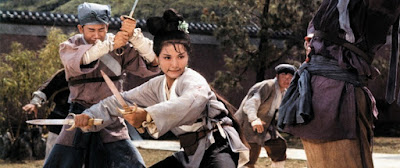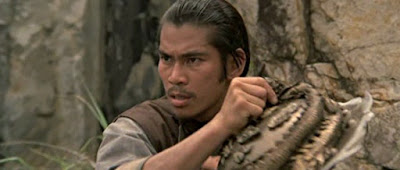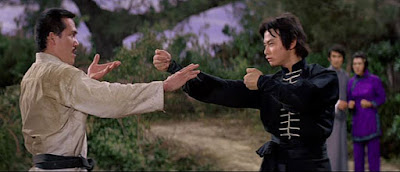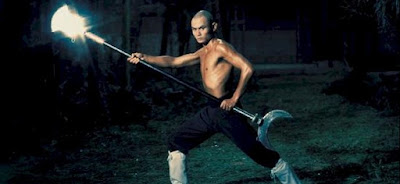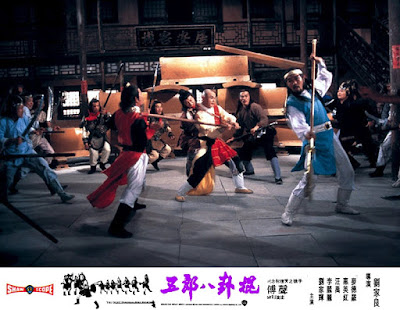When Kill Bill: Volume 1 first premiered in
theaters and the opening credits were a visual of the Shawscope logo, with
those trumpets sounding off, how many viewers actually knew what that meant?
For many others, it was a geek freak out that brought back tons of memories of
crazy martial arts action; Shaolin monks battling ninja, evil masters with
crazy long eyebrows, intense training sequences, one-armed swordsmen, absurd
monsters, and so much more. Not that long ago the Shaw Brothers ruled Hong Kong
Cinema. Despite no longer making movies, their influence is still strong today.
This can be seen by the filmmakers Quentin Tarantino and Tsai Ming-Liang paying
tribute to the studio, the character of Pai Mei being used and veteran Shaw
actors such as Gordon Liu still making appearances (1) .
The Shaw Brothers had been involved in the film industry since the 1920’s, but
the Hong Kong studio wasn’t founded until 1958 (2) .
Before Shaw came onto the scene; the major stars were women, the primary
dialect used was Cantonese, and musicals and romances ruled the box office (2) . But everything changed
in 1967 when they released The
One-Armed-Swordsman, Chang Cheh’s “macho, blood-soaked, Mandarin language
martial-arts movie that captured the rage and social turmoil of the sixties,
and a studio was born” (2) . At its height, they
had one of the largest working studios in the world. Called Movie Town, it had
somewhere near “850,000 square feet of sound stages, processing labs,
residences for casts and crew, and a back lot…of temples, fortresses…and
battlefields from 5,000 years of Chinese history” (1) . They employed
around 1,500 actors and technical employees, 500 of which lived on the studio (3) . They were able to
produce around 40 films a year and since there was no union, the actors could
work as long as 24 hours a day (3) . They shot the
pictures without sound in order to save time and then recorded the sound later,
similar to the Italian film industry. They also invented their own machine for
making martial art effects sound (3) .
Their reign started to end when other filmmakers branched off to create their
own studios, such as Golden Harvest (2) .
Shaw decided to focus on its television station TVB, and stopped making motion
pictures in 1986. Many of Hong Kong cinemas great directors and actors got
their start either working on a Shaw film or on their television station
Television Broadcast Limited, commonly known as TVB (2) .
An epic wuxia masterpiece directed by King Hu, is considered
to be one of the greatest Hong Kong films ever made. A group of bandits kidnap
a General’s son in exchange for the release of their imprisoned leader. Golden
swallow is sent to rescue the boy, along the way a local drunk named Fan Da-Pei
comes to her aid and they eventually battle the bandits and their evil leader.
Everything is top notch in this movie, which is why it’s
considered to be one of the greatest ever. King Hu’s directing was meticulous,
with strong visuals, art direction, and costume designs (4) . One interesting
visual that he used is the addition of smoke into various scenes; Hu thought
that it made the scene look more appealing (4) . One production story
was that he spent over two hours on the set working on the Drunken Master’s
clothing, in order to make it just right (4) . The style of
fighting employed was different than in previous cinematic martial arts fights.
It was more based on the Peking Opera Style and a ballet, where the fights are
more layered (4) . Another big
difference between this and most of the future Shaw Brother movies are the roles
that females play. In this movie, golden swallow plays the main character and she
does not wear the typical ornate dresses that had been common for female
actresses. Hu was concerned with having dominant female characters and “grace:
the fleetness of motion and lightness of touch” (1) .
The other leading director for Shaw at the time was Chang Cheh, who was more
interested in “yang gang (staunch masculinity)” (4) . King Hu left after
completing this production because he was not happy with the standards of the
female and male roles (4) .
“Protect
Your Neck!” (5) .
The emperor is nervous and wants his critics to be eliminated secretly, so he
puts Sing Yang in charge. He creates a new weapon called the flying guillotine,
which can behead a man from one hundred paces away. After having it created,
the emperor orders twelve guardsmen to master it. Ma Teng and Fend Ku excel at
the weapon. But Ma Teng ends up disagreeing with the assassinations and becomes
a hunted man, which sounds similar to Finn’s story arc in The Force Awakens. Director Meng Hua Ho and writer Kuang Ni have
broken away from the traditional martial arts genre elements in this film, with
fewer and more believable fight scenes. This is done in order to focus further
on the actual weapon and the dramatic story elements.
The
film became a huge success around the world and a grindhouse hit in the U.S. It
spawned similar guillotine movies from other studios, most notably Master of the Flying Guillotine starring
former Shaw Brother actor Jimmy Wang Yu. The popularity is most likely due to
the combination of historical figures, well developed characters, and a weapon
that has been rumored to have existed. The emperor Yung Cheng ruled the Manchu
Dynasty from 1722-1735 (6) .
The film and DVD extras state that both the events and weapon are real, but the
weapon had to be fabricated because no one had survived in order to give
details of its design (7) . They apparently all
lost their heads like in Alice in
Wonderland. This movie most likely has the distinction of having the most
on screen decapitations, at around twenty five. The decapitation scenes are
quite dramatic. As with most Shaw Brother’s productions, the sets are excellent
and there is a great deal of locale shots. Chen Kuan-Tai’s acting is good in
this as well, playing the more humane character that tries to escape and start
a family. The final fifteen or so minutes of this are pretty intense, despite
the lack of traditional martial arts action.
“A
fight for vengeance ends in death!” (8) This tagline is a
fitting description for a movie that features the evil historical figure Pai
Mei, who has some mad skills. In a trademark Chia-Liang Liu opening credits
scene, Pai Mei and a Shaolin master have an epic battle set against a red
backdrop. Some of the Shaolin students are killed, the rest escape and are able
to join a traveling opera group that is a front for the revolution. The son of
one of the students trains in order to challenge and defeat Pai Mei.
This
is worth watching just because Pai Mei is in it. You just can’t pass up the
chance to watch his internal kung-fu, where he is able to retract his man parts
up into his groin. Lo Lieh is masterful as this character. Chi-Liang Liu
changed martial arts cinema for the Shaw Brothers by “revolutionizing fight
choreography in ways that have yet to be surpassed. Liu made lightning-fast
movements not only intelligible but
indelible, and the pas de deux he designed for competing modes of
combat-short/fast Southern Shaolin styles vs. Wide/weaving Northern Wudang
styles-are as essential to any study of dance in cinemas the disparate
dazzlements of Fred Astaire or Maya Deren” (1) .
A
categorical masterpiece brought to us by Chi-Liang Liu, who displays an
exhibition of both Chinese and Japanese martial arts. Gordon Liu plays Ho Tao,
a kung fu student who is forced into an arranged marriage with a Japanese
woman. Yumiko Koda (Yuka Mizuno) knows karate and Ho Tao finds it to be violent
and too masculine. There is conflict between both of them over which country
has the superior martial arts and miscommunication leads the Japanese to send a
group of Karate experts to challenge Ho.
What
transpires because of this challenge is simply martial arts movie magic. The
combination of Chi-Liang Liu’s direction and choreography and Gordon Liu’s
martial arts skill and physical ability in this film can be compared to any of
the greatest filmmakers in our history. Yes, it is that good. There are roughly
thirteen fight scenes using close to twenty different weapons plus various styles
of martial arts; including Karate, Judo, Crane Style, Drunken Style, Ninjitsu,
Kung Fu, and yes Crab Style. While not as well known as Bruce Lee, Jet Li, or
Jackie Chan because he never acted in an American motion picture until Kill Bill, Gordon Liu is one of the
greatest martial arts actors of all time.
“The Kung Fu Classic That
Started It All!” was the tagline for what is considered to be one of the
greatest kung fu films (9) . Gordon Liu plays
legendary monk San Te, who starts off as a revolutionary in a local rebellion
and ends up joining the Shaolin monks and training in martial arts. The
training includes a series of 35 different levels of tests, in which the
student must master one before advancing to the next level.
For many fans and literary
critics of the genre, this “ranks as one of the all-time classics of Asian
martial arts films and was at the forefront of a new form of martial arts
moviemaking that showcased the skill and practice of Shaolin Kung Fu” (10) . It has influence
beyond just the film industry. In Wu Tang Clan’s first album Enter the Wu-Tang (36 Chambers), there’s
a line that goes “Yo Meth, where my Killer tape at” which is referencing a VHS
tape of Master Killer (10) . While this may
not be Gordon Liu’s greatest movie, it sent him down a path of playing a
Shaolin monk for the quite some time.
Featuring
the group of Shaw Brother actors referred to as the Venom Mob, there is a lot
of mayhem and mutilation in this action packed adventure. A ruler goes insane
after his enemies kill his wife and cut off his sons forearms. The son ends up
getting mechanical arms and has a bad temper and cripples anyone that he
dislikes, like King Joffrey from Game of
Thrones. Four of these men seek out a kung fu master in order to get
revenge for being crippled by the martial arts master and his son.
The
story has a darkness that is similar to a Shakespearean tragedy. There are intense
training scenes that showcase all of the actor’s talents and acrobatic abilities,
while also focusing on the theme of brotherhood and being united. The action is
simply amazing. The storyline of crippled martial artists was copied in a movie
called Crippled Masters, in which
actual amputees are the actors.
This
was the first Chang Cheh movie that no longer featured the Venom Mob, with most
of them “jockeying for space” and three returning to Taiwan to make films (11) . Cheh found a new
star in Tien-Chi Cheng, who plays Shao Tien-Hao. Two rival martial arts schools
have a competition when Chief Hong challenges Yuan Zeng. Hong brings in a
Japanese samurai to be one of the competitors, who ends up being defeated by
one of Zeng’s students. The samurai in defeat commits suicide and has a letter
sent back to Japan asking to be avenged. The five element ninjas show up and all
out craziness ensues.
This
is quite possibly Chang Cheh’s most violent and bloody movie, which is one
reason why it is so popular and falls in the realm of a cult classic. The ninja
costumes and different weapons used stand out. Add to that the story of the
hero creating techniques and weapons in order to defeat them makes it quite
memorable. The action and fight choreography is outstanding, especially the
last twenty or so minutes for the final battle.
This
is a beautiful and bizarre fantasy based martial arts motion picture that is a
strange hybrid of a Chang Cheh blood fest and a G rated anime. It would almost
be like if an American studio made a movie that was a combination of The Neverending Story and The Teletubbies. A mythical lute has
resurfaced after some time and the possessor, called the Demon of the Lute, is
going around killing all of the martial arts masters with it. The only way that
it can be destroyed is by using the two other martial treasures, a fiery bow
and arrow. Both have also been missing. A group of heroes is sent out on a
quest to find the missing treasures and save the day, wait that’s the Lord of the Rings trilogy.
This
is the definition of what a cult film is. It may be obscure or unpopular for a
Shaw Brothers production, but it needs to be seen at least once in a lifetime.
It has good action and an endless amount of madness; hermaphrodites, villains
with extending beards and appendages, a giant pair of golden scissors, a flying
disco ball, a villain with a giant red afro and his thunder flying wheels,
attacking trees reminiscent of Evil Dead,
among others.
The
film is loosely based on the Yang family who were defeated by the Mongols. After
their deaths, the fifth brother goes to a Shaolin temple to improve his pole
fighting skills in order to seek revenge. He is able to persuade the abbot to
teach him the monk’s pole style.
This
was both Chi-Liang Liu and Gordon Liu’s masterpiece. The story and acting is
strong, the training sequences are excellent with the wooden wolves, it has the
best pole fighting ever, and the final battle is just outstanding. Even though kung
fu movies were going “out of fashion;”Jackie Chan and Tsui Hark were both
redefining the genre in their own way and yet this “film shows that Liu could
match, if not surpass, any of his rivals” (12) .
This
movie is simply a total phantasmagoric mind-fuck. It’s a melting pot of ninjas
versus Chinese clans versus each other; add in wizard sorcery, wire fu, sci-fi
special effects, silkworm style, fortune tellers, Shaolin monks, spraying
blood, fishing, a swordfight by the sea, acupuncture, medicine men, a bunch of
drums, great hand fighting, and stunning swordplay. Oh, and of course killer
heartbeat style and the phantom technique, which makes your heart burst out of
your mouth. Cult film fans eat your heart out.
Break out some Crane style and share this list
Works Cited
1. The Shaw Brothers' Elephant. Stephens,
Chuck. 2004, Filmcomment, pp. 52-57.
2. Out of the
Ashes. Hendrix, Grady. 2014, FilmComment, pp. 28-30.
3. Dunlop, Geoff.
Taste for Adventure; Fists of Fire. 1975.
4. Hu, King. Come
Drink With Me Extras. 1966.
5. IMDB. IMDB. [Online]
1 20, 2016. http://www.imdb.com/title/tt0071512/?ref_=fn_al_tt_4.
6. Global Security. Global
Security. [Online] 1 20, 2016.
http://www.globalsecurity.org/military/world/china/emperor-manchu-yongzheng.htm.
7. The Flying
Guillotine Extras.
8. IMDB. IMDB. [Online]
1 21, 2016. http://www.imdb.com/title/tt0076168/?ref_=fn_al_tt_1.
9. IMDB. IMDB. [Online]
1 21, 2016. http://www.imdb.com/title/tt0078243/taglines?ref_=tt_stry_tg.
10. Fu, Poshek.
China Forever. Chicago : University Press, 2008.
11. Meyers, Ric.
Films of Fury. guilford : emery books, 2011.
12. Hunt, Leon.
Kung Fu Cult Masters. New York : Wallflower Press, 2003.


